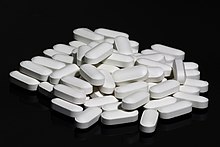

This lead needs additional citations for verification. Please help improve this articlebyadding citations to reliable sources in this lead. Unsourced material may be challenged and removed.
Find sources: "Hypervitaminosis" – news · newspapers · books · scholar · JSTOR (February 2017) (Learn how and when to remove this message) |
| Vitamin overdose | |
|---|---|
 | |
| Supplements of calcium and vitamin D | |
| Specialty | Toxicology |
| Causes | Excessive consumption of vitamins |
Hypervitaminosis is a condition of abnormally high storage levels of vitamins, which can lead to various symptoms as over excitement, irritability, or even toxicity. Specific medical names of the different conditions are derived from the given vitamin involved: an excess of vitamin A, for example, is called hypervitaminosis A. Hypervitaminoses are primarily caused by fat-soluble vitamins (D and A), as these are stored by the body for longer than the water-soluble vitamins.[1]
Generally, toxic levels of vitamins stem from high supplement intake and not always from natural sources but rather the mix of natural, derived vitamins and enhancers (vitamin boosters). Toxicities of fat-soluble vitamins can also be caused by a large intake of highly fortified foods, but natural food in modest levels rarely deliver extreme or dangerous levels of fat-soluble vitamins.[2] The Dietary Reference Intake recommendations from the United States Department of Agriculture define a "tolerable upper intake level" for most vitamins.
For those who are entirely healthy and do not experience long periods of avitaminosis, vitamin overdose can be avoided by not taking more than the normal or recommended amount of multi-vitamin supplement shown on the bottle and not ingesting multiple vitamin-containing supplements concurrently.[3]
A few described symptoms:[3]
With few exceptions, like some vitamins from B-complex, hypervitaminosis usually occurs with the fat-soluble vitamins A and D, which are stored, respectively, in the liver and fatty tissues of the body. These vitamins build up and remain for a longer time in the body than water-soluble vitamins.[2] Conditions include:
Prevention in healthy individuals not having any periods of avitaminosis or vitamin (vegetables) lack for 2 years at least is by not taking more than the expected normal or recommended amount of vitamin supplements.[3]
In the United States, overdose exposure to all formulations of "vitamins" (which includes multi-vitamin/mineral products) was reported by 62,562 individuals in 2004 with nearly 80% of these exposures in children under the age of 6, leading to 53 "major" life-threatening outcomes and 3 deaths (2 from vitamins D and E; 1 from a multivitamin with iron).[4] This may be compared to the 19,250 people who died of unintentional poisoning of all kinds in the U.S. in the same year (2004).[5] In 2016, overdose exposure to all formulations of vitamins and multi-vitamin/mineral formulations was reported by 63,931 individuals to the American Association of Poison Control Centers with 72% of these exposures in children under the age of five. No deaths were reported.[6]
|
| |||||
|---|---|---|---|---|---|
| Protein-energy malnutrition |
| ||||
| Vitamin deficiency |
| ||||
| Mineral deficiency |
| ||||
| Growth |
| ||||
| General |
| ||||
|
| |||||||||||||
|---|---|---|---|---|---|---|---|---|---|---|---|---|---|
| |||||||||||||
| Inorganic |
| ||||||||||||
| Organic |
| ||||||||||||
| Pharmaceutical |
| ||||||||||||
| Biological2 |
| ||||||||||||
| Miscellaneous |
| ||||||||||||
| |||||||||||||